Serum screening in first trimester to predict pre-eclampsia, small for gestational age and preterm delivery: systematic review and meta-analysis
- PMID: 26303460
- PMCID: PMC4548561
- DOI: 10.1186/s12884-015-0608-y
Serum screening in first trimester to predict pre-eclampsia, small for gestational age and preterm delivery: systematic review and meta-analysis
Abstract
Background: Early assessment before the establishment of placental dysfunction has the potential to improve treatment and prognosis for clinical practice.The objective of the study is to investigate the accuracy of serum biochemical markers(Pregnancy- Associated Plasma Protein-A (PAPP-A), human Chorionic Gonadotropin (hCG), Placental Growth Factor (PlGF), Placental Protein 13 (PP13) used in first trimester serum screening in predicting preelampsia, small for gestational age (SGA) and preterm delivery.
Methods: The data sources included Medline, Embase, Cochrane library, Medion, hand searching of relevant journals, reference list checking of included articles and contact with experts. Two reviewers independently selected the articles. Two authors independently extracted data on study characteristics, quality and results.
Results: The results showed low predictive accuracy overall. For preeclampsia, the best predictor was PlGF; LR + 4.01 (3.74, 4.28), LR-(0.67, 0.64, 0.69). The predictive value of serum markers for early preeclampsia was better than that of late preeclampsia. For SGA the best predictor was PP13; LR+ 3.70 (3.39, 4.03), LR- 0.70 (0.67, 0.73). For preterm delivery, the best predictor was PP13; LR+ 4.16 (2.72, 5.61), LR- 0.56 (0.45, 0.67).
Conclusion: First trimester screening analytes have low predictive accuracy for pre-eclampsia, small for gestational age and preterm delivery. However, the predict value of first trimester analytes is not worse than that of the second trimester markers.
Figures
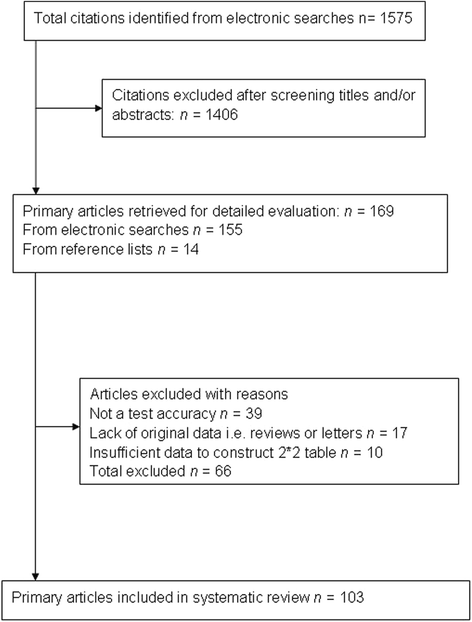
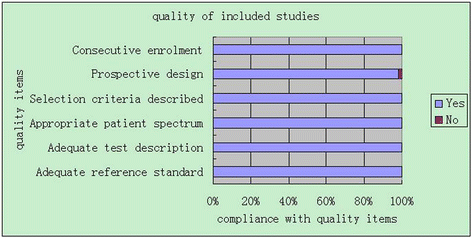
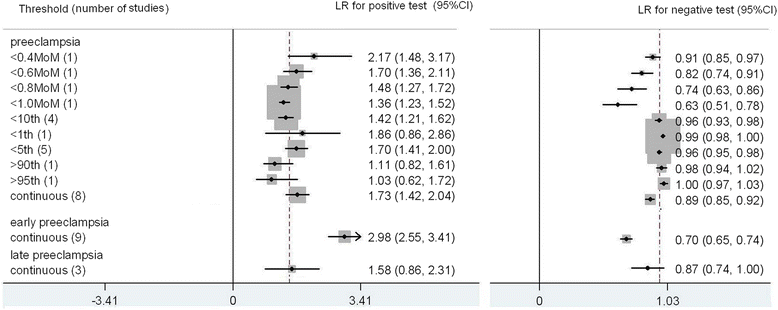
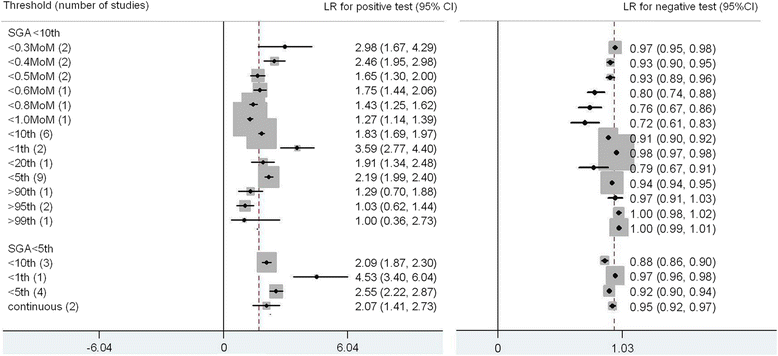
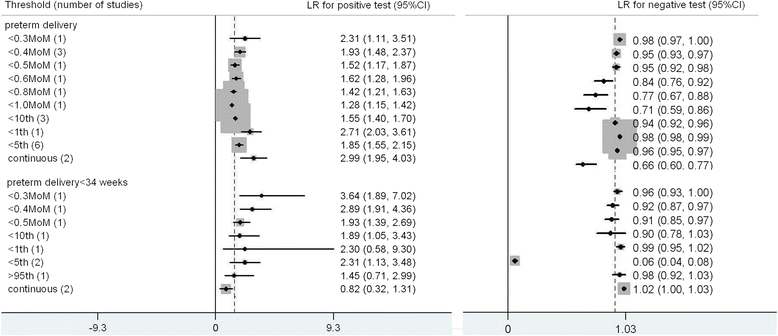


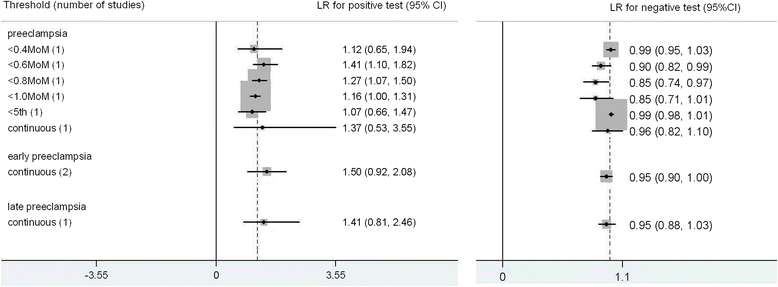
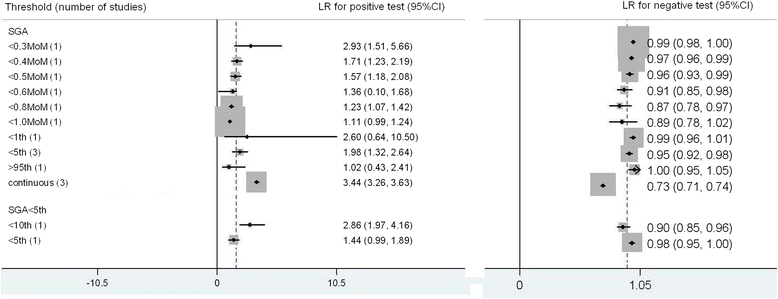

Similar articles
-
First trimester ultrasound tests alone or in combination with first trimester serum tests for Down's syndrome screening.Cochrane Database Syst Rev. 2017 Mar 15;3(3):CD012600. doi: 10.1002/14651858.CD012600. Cochrane Database Syst Rev. 2017. PMID: 28295158 Free PMC article.
-
First trimester serum tests for Down's syndrome screening.Cochrane Database Syst Rev. 2015 Nov 30;2015(11):CD011975. doi: 10.1002/14651858.CD011975. Cochrane Database Syst Rev. 2015. PMID: 26617074 Free PMC article.
-
First trimester screening of maternal placental protein 13 for predicting preeclampsia and small for gestational age: in-house study and systematic review.Placenta. 2012 Sep;33(9):735-40. doi: 10.1016/j.placenta.2012.05.012. Epub 2012 Jun 28. Placenta. 2012. PMID: 22748852
-
Serum screening with Down's syndrome markers to predict pre-eclampsia and small for gestational age: systematic review and meta-analysis.BMC Pregnancy Childbirth. 2008 Aug 4;8:33. doi: 10.1186/1471-2393-8-33. BMC Pregnancy Childbirth. 2008. PMID: 18680570 Free PMC article.
-
First and second trimester serum tests with and without first trimester ultrasound tests for Down's syndrome screening.Cochrane Database Syst Rev. 2017 Mar 15;3(3):CD012599. doi: 10.1002/14651858.CD012599. Cochrane Database Syst Rev. 2017. PMID: 28295159 Free PMC article.
Cited by
-
First trimester screening for pre-eclampsia.Obstet Med. 2016 Sep;9(3):106-12. doi: 10.1177/1753495X16649074. Epub 2016 May 14. Obstet Med. 2016. PMID: 27630745 Free PMC article. Review.
-
Nested case-control study reveals increased levels of urinary proteins from human kidney toxicity panels in women predicted to develop preeclampsia.Int Urol Nephrol. 2016 Dec;48(12):2051-2059. doi: 10.1007/s11255-016-1397-6. Epub 2016 Aug 29. Int Urol Nephrol. 2016. PMID: 27571961
-
Metabolomics for predicting fetal growth restriction: protocol for a systematic review and meta-analysis.BMJ Open. 2018 Dec 6;8(12):e022743. doi: 10.1136/bmjopen-2018-022743. BMJ Open. 2018. PMID: 30530473 Free PMC article.
-
Development and validation of a predictive model for preeclampsia: a retrospective cohort study.Arch Gynecol Obstet. 2025 Jun 1. doi: 10.1007/s00404-025-08076-6. Online ahead of print. Arch Gynecol Obstet. 2025. PMID: 40450650
-
Effect of Lipid-Based Multiple Micronutrients Supplementation in Underweight Primigravida Pre-Eclamptic Women on Maternal and Pregnancy Outcomes: Randomized Clinical Trial.Medicina (Kaunas). 2022 Nov 30;58(12):1772. doi: 10.3390/medicina58121772. Medicina (Kaunas). 2022. PMID: 36556974 Free PMC article. Clinical Trial.
References
-
- Dugoff L, Hobbins JC, Malone FD, Porter TF, Luthy D, Comstock CH, et al. First-trimester maternal serum PAPP-A and free-beta subunit human chorionic gonadotropin concentrations and nuchal translucency are associated with obstetric complications: a population-based screening study (the FASTER Trial) Am J Obstet Gynecol. 2004;191(4):1446–1451. doi: 10.1016/j.ajog.2004.06.052. - DOI - PubMed
Publication types
MeSH terms
Substances
LinkOut - more resources
Full Text Sources
Other Literature Sources
Medical
Miscellaneous

